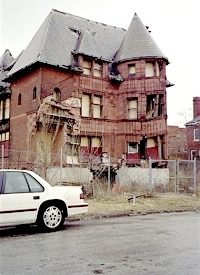
It used to be one of the great cities of a great nation, a thriving, prosperous metropolis humming night and day with the machinery of America’s industrial superiority. In 1950, individuals and families were still streaming to Detroit to work in the ever-growing automotive industry, and as the U.S. Census Bureau crunched the numbers that year they found the Motor City had grown to an astounding population of 1,849,568 people, with the city fathers predicting two million and beyond in the coming years.
Sixty years later the landscape of Detroit looks far different, with latest numbers from the U.S. Census Bureau showing the city has lost 25 percent of its population in the last ten years, from 951,270 in 2000 to 713,777 in 2010, its lowest population since the 1910 census.
Across the river in Ontario, Jack Lessenberry writing in the Windsor Star reflected on the ghost town in the making known as the “ruins of Detroit,” noting that while at one time the mass exodus from Detroit was considered “white flight,” today it is the largely black and Hispanic populations that are fleeing a community that is largely ruled by crime, unemployment, and an assortment of other social ills. “To some extent it is the fear of crime, the lack of grocery stores, the higher cost of everything, including auto insurance” that has fueled the race to leave Detroit, Lessenberry noted. “There are countless stories of people, white and black, who struggled valiantly for years to stay in Detroit, before giving up in exhaustion.”
While over the past ten years or so city boosters have attempted to paint a positive picture of “a new generation of young urban pioneers who were returning to Detroit from the suburbs, living in lofts, and creating an artistic and urbane lifestyle,” Lessenberry wrote, in reality “the census indicated that this was pretty much a fantasy.”
With Detroit’s dramatic plummet, Michigan’s population as a whole has, predictably, also seen a noticeable drop, from 9.94 million to 9.89 million over the same time period, a decrease that has cost the state another seat in Congress. “At its peak, after the 1960 census, Michigan had 19 seats in the U.S. House of Representatives,” noted CNN. “The state’s Capitol Hill clout has eroded, one or two seats a decade, since 1980. Now, it’s down to just 14.”
In response to the new Census figures, Michigan’s Republican Governor Rick Snyder said it was high time to re-invent Detroit and the state, infusing its collective psyche with fresh ideas for growth. “We cannot cling to the old ways of doing business,” Snyder said in a statement. “Michigan will not succeed if Detroit and other major cities don’t succeed. Losing our best and brightest young adults to other states, or failing to rejuvenate our urban areas, are not acceptable options.”
Conservative analysts have pointed out that a big part of the “re-invention” needed to turn Detroit around must come in policy and political philosophy. “For the record, Detroit has been under liberal leadership for decades,” noted Mike Brownfield of the Heritage Foundation. “And the city’s big problem today is that its road forward is blocked by the very same political machine that helped deliver it to its state of ruin.”
Brownfield singled out the politically powerful — and irrevocably liberal — teacher’s union as just one significant road block to progress. “In 2003, a philanthropist pledged $200 million for the creation of 15 charter schools in the city,” recalled Brownfield. “Despite the city’s tragic public school system, the plan failed and the offer was withdrawn following protests by the Detroit Federation of Teachers.” Eight years later and it is more of the same, as the city lies in ruins. “A state-appointed emergency financial manager has proposed sweeping changes to the city’s public school system,” continued Brownfield, “including a plan to convert 41 of the city’s schools to charter schools. Guess who’s opposed to the reforms? That very same union.”
Brownfield noted that after eight years of destructive liberal policies under Democratic Governor Jennifer Granholm, Michigan received a breath of fresh air with the election of Snyder, who has embarked “on efforts to change the way the state does business, including tax reform, spending cuts, and empowering emergency financial managers to tackle problems in cities and schools. Who’s opposed to his reforms? Unions, once again, in Wisconsin-style protests.”
Writing in the Wall Street Journal, William McGurn pointed out that Michigan’s economic plight is different from other struggling states. “It is a basket case,” he wrote, “with worse to come if things do not change quickly — especially in the relation of the public to the private sector. McGurn quoted Michael LaFaive of the Michigan-based Mackinac Center as saying that many of the media encouraged protestors in such embattled states as Wisconsin and Michigan “seem to think the war is between rich and poor. But the real class war today is between government and the people who pay for it. And the government’s been winning.”
The pathetic deterioration of Detroit that the world is witnessing boils down to decades of destructive liberal policy, wrote Michael Barone in the Washington Examiner. “When people ask me why I moved from being a liberal to being a conservative, my single-word answer is Detroit,” Wrote Barone. “The liberal policies which I hoped would make Detroit something like heaven have made it instead something more like hell.”
Ultimately, those same policies are what drove nearly a quarter of a million people and their families from one of America’s once-great cities. And it will take leaders of integrity with stiff backbones and thick skin to stand firm against liberal protestors and their puppet masters in union halls and political back rooms to keep the same thing from happening in other cities great and small.
Photo: Historic William Livingstone House in Detroit’s Brush Park neighborhood was demolished on September 15, 2007.



